Around the Oval
Her Kingdom for a Stick
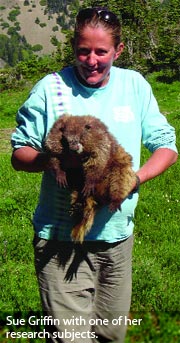
Can you guess what tool UM forestry and conservation doctoral student Sue Griffin finds most useful in her award-winning Olympic marmot research project? A stick. Yes, a stick, broken from a dead tree branch.
She places sticks in marmot burrows. When the marmot pops out of its hole, a DNA sample is left on the stick from the marmot’s fur. Griffin uses this method—along with radio telemetry and field observation—to gather data on marmot movement in Washington state’s Olympic National Park.
Her project has earned her one of eight $78,000 annual Canon Park Science Scholars Program scholarships. Awarded on a com-
petitive basis, the scholarship provides selected Ph.D. students the funds to conduct research essential to the conservation of national parks.
So far, Griffin has seen very little movement from the marmots—less than she expected based on previous research. “We believe this is because the density of marmots is very low, and so there is little competition for space, food, mates, or other resources—which would normally cause young marmots to leave.”
Griffin has discovered something else she didn’t expect: a single, voracious predator. “We have seen very high mortality rates among the marmots, particularly in one area of the park,” Griffin says. “Based on carcasses recovered with the radio-telemetry and predation events witnessed by park visitors, it appears that a single coyote was killing a lot of marmots and may have driven them to extinction in some areas. We have reason to believe this coyote is now dead, and it will be interesting to see if marmot numbers rebound or if other coyotes move into the area.”
“I think [Sue Griffin] winning this most prestigious award should be underscored,” says Scott Mills, associate professor of forestry and conservation. “She’s very active in educating people about how science affects everyday lives. She’s done a wonderful job of educating the public, as well as gaining scientific knowledge.”
Because understanding movement patterns is important to sustaining the existence of a species, Mills hopes that by studying the marmots, Griffin will find patterns that could be applied to species activity elsewhere.
The Canon is the latest in a string of awards Griffin has racked up in her first two years of research. She was a 2004 recipient of the $10,000 Budweiser Conservation Scholarship and has won a National Science Foundation fellowship, Environmental Protection Agency fellowship, and a National Science Foundation grant. —Paddy MacDonald
Awards Galore
It’s that time of year. UM’s University Relations team is racking up regional and national awards. The department hit a sort of grand slam with wins in four categories in the Admissions Marketing competition: gold awards for the Montanan, the 2004 President’s Report, and Research View and a merit award for the Montanan’s voluntary subscription ad.
The team returned from the District VIII Council for the Advancement and Support of Education conference in Seattle with seven awards: a silver for the President’s Report, four silvers in writing for Paddy MacDonald, Cary Shimek, Patia Stephens, and Joan Melcher; a bronze for Research View, and a bronze for the cover of Vision magazine. As we went to press, Montanan staff learned the magazine was a finalist in two categories for Maggie awards, given out by the Western Publications Association.
Talk To Us
 The
Montanan staff is always looking for feedback from our
readers. How many of you know about the Montanan Chatroom?
The
Montanan staff is always looking for feedback from our
readers. How many of you know about the Montanan Chatroom?
Not nearly enough, it would seem. It’s a discussion board connected to our site. You can log directly on to the Montanan’s Web site, www.themontanan.us, and post comments to the site or share thoughts with other readers.
Your posts also could be used as letters to the editor in the magazine. Even more interesting are the links at the ends of each story published in the Montanan. After reading a story, either in print or on the Web, you can use these links to post your comments about the story.
Hearing your thoughts about what we’ve done is very helpful to us in determining what sorts of stories to plan for future issues.
To further enhance our connection with readers, we will conduct a random national telephone survey this spring—to learn what you like about the magazine, what you could live without, and what sorts of suggestions you have for improving the magazine. We’re looking forward to talking with hundreds of you.
The more we hear from you, the better we get. So call, write, and log on. Your opinions count!
The Montanan Chatroom is closer than you think — CHAT NOW!
Smithsonian Honor
| |
|
|
 Stanley with part of UM's Paleontology Research Collection, which has more than 100,000 specimens. |
||
| |
|
|
UM geology Professor George Stanley lately found himself among distinguished company. He was named to a three-year appointment as a research associate of the Smithsonian Institution’s National Museum of Natural History in Washington, D.C.
The honor is awarded to “scientists of distinction who maintain a scholarly affiliation with the Smithsonian and its research community.”
An invertebrate paleontologist and inter-nationally recognized expert on modern and ancient coral reefs, Stanley joined the UM faculty in 1982. He has discovered dozens of previously unknown species during the course of his research and has written and edited six books and published more than 100 scientific writings.
“I am surprised and elated at this honor,” Stanley says, “and I hope to undertake collaborative research with the Smithsonian during the next three years.”
Before coming to UM, Stanley worked from 1979 to 1981 as a paleobiologist at the Smithsonian’s Museum of Natural History. That work was followed by a one-year Fulbright fellowship to Germany. On sabbatical this year, Stanley will travel to China, Germany, and Japan to conduct research.
Stanley with part of UM’s Paleontology Research Collection, which has more than 100,000 specimens.
Think Local, Think Fresh
 The
next time you sit down to eat at a UM dining venue, think
local, think fresh. In the past two years, University Dining
Services has gone as local as possible with its food budget and
it’s because of the Farm to College program. Before the
program’s inception in May 2003, dining services spent its
$2 million budget in states all over the country. Now Montana and
other Northwest states are getting a much bigger piece of the
pie—$425,000 this year.
The
next time you sit down to eat at a UM dining venue, think
local, think fresh. In the past two years, University Dining
Services has gone as local as possible with its food budget and
it’s because of the Farm to College program. Before the
program’s inception in May 2003, dining services spent its
$2 million budget in states all over the country. Now Montana and
other Northwest states are getting a much bigger piece of the
pie—$425,000 this year.
The program’s purpose is twofold: to supply fresher products that do not have to undergo large amounts of processing and added preserv- atives and to support Montana producers. The program now offers food from thirty-five Montana vendors.
Mark LoParco, director of UDS, says the greatest success of the program so far is “the relationships and commitments we have with the vendors.” He says he likes how the program supports the community, giving it a sustainable revenue.
Mark Wehri, general manager for Western Montana Growers’ Co-op in Arlee, which supplies various fruits and vegetables to UM, agrees. He says sales to the Farm to College program account for ten percent of the co-op’s sales this year and next year he expects it to be around twenty percent of their business.
Neil Trunbull, general manager of Montola Growers, Inc., based in Culbertson, supplies safflower oil to UM. He says he is very satisfied with the Farm to College program and encourages more use of it. It gives more than 250 farmers in Montola Growers encouragement, he says. Personally, he says he feels pleased that his kids who are at UM are receiving a better quality of food. Instead of buying what is cheaper, he says he respects University Dining Services for buying what is healthier.
The people who created the Farm to College program wanted to respond to the growing expectations of customers regarding the origins of the food they eat. Will Tusick, office manager at Montana Natural Beef in Ronan and a participant in the program, thinks its success has to do with people realizing they “need to take responsibility for where their food is coming from.” The program also “helps to focus the state’s attention on the fact that the University is a business,” LoParco says. He says it helps people make the connection that the University has to maintain business relationships just like any other business.
Personally, LoParco says, what’s been the most rewarding for him is “getting out to the places where people are doing this (farming and ranching). It feels good to be helping people who work hard and have had to diversify their revenue streams to keep their way of life.” — Brianne Burrowes
Parting with Pantzer
 It
was the late ’60s, the peak of the Vietnam War, and
universities across the country were swelling with draft dodgers,
protestors, and passion. Students displayed their right to free
speech on a frequent basis—boycotting classes and staging
protests on the Oval. It was a challenge for any university
president.
It
was the late ’60s, the peak of the Vietnam War, and
universities across the country were swelling with draft dodgers,
protestors, and passion. Students displayed their right to free
speech on a frequent basis—boycotting classes and staging
protests on the Oval. It was a challenge for any university
president.
One—UM’s Robert T. Pantzer—firmly and peaceably led his university through the tumultuous years with dignity. At a time when there was an outbreak of violence on university campuses, Pantzer sided with students to keep theirs safe. “I think Pantzer was largely responsible for the fact that there was no violence here,” says retired UM journalism Professor Bob McGiffert, who taught for twenty-nine years.
Pantzer had a trick, McGiffert says: he made it clear that he thought students had a right to express their opinions. “He was particularly understanding of the war protest position,” he says. UM history Professor Harry Fritz agrees. The late ’60s to early ’70s were the toughest times to be a university president, he says. There was booming enrollment among students and a sticky war. “He guided the ship and took students seriously,” Fritz says.
In 1971, when Cambodia was invaded, student organizers called a strike. Pantzer took to the Oval to discuss the strike with students. During his message, he read aloud the telegram he had sent to President Nixon. The telegram took the position of many
students at the time and disparaged the war. He sympathized with students’ grievances and addressed them, Fritz says.
“His steady hand and remarkable courage during some very trying times kept the University on course and also assured students of the environment in which to study and learn,” says UM President George Dennison.
But Pantzer, who died last fall, is remembered for more than his peacekeeping ways. He had what Fritz described as a “normal” academic background. He didn’t come out of the cookie-cutter college president mold. He graduated from UM’s School of Business Administration before serving several years in the Second World War. In combat he earned a Purple Heart and Bronze Star. After the war Pantzer returned to UM to pursue a degree in law. He was a lawyer for half a decade before again returning to UM, this time to become a professor in the business school. He was named acting president at the University before being named the twelfth president of UM, serving from 1966 to 1974.
Fritz says he believes another reason Pantzer had such an effective presidency was because of the people who served under him. Namely, Fritz says, Richard Landini, who served as UM Academic Vice President under Pantzer. He stayed one year after Pantzer left and then took a job as President of Indiana State University. Landini and Pantzer died within one week of each other last October. — Brianne Burrowes
Way out There
 One
UM scientist is way out there. In space, that is. Dan
Reisenfeld, an assistant professor of physics and astronomy, is
helping NASA design a research satellite to map the region in
space called the termination shock. It’s about 100 times
farther from the Sun than Earth—where the solar wind slows
down and merges with interstellar space.
One
UM scientist is way out there. In space, that is. Dan
Reisenfeld, an assistant professor of physics and astronomy, is
helping NASA design a research satellite to map the region in
space called the termination shock. It’s about 100 times
farther from the Sun than Earth—where the solar wind slows
down and merges with interstellar space.
“There is a boundary between our neighborhood and the rest of the universe, and we want to understand that boundary,” Reisenfeld says. “It’s where the influence of the Sun ends and the true void of space begins.”
NASA recently approved funding for the Interstellar Boundary Explorer (IBEX), with a price tag of about $134 million; the satellite is scheduled to launch in 2008.
Reisenfeld was part of a four-member team at Los Alamos National Laboratory in New Mexico and Southwest Research Institute in Texas that designed a prototype for one of two instruments that will fly aboard IBEX. The new team will design IBEX-Hi, an instrument that uses a large-aperture camera to detect high-energy particles coming from the edge of the solar system.
Reisenfeld is developing a lab at UM to assist with design of the IBEX-Hi instrument. “Hopefully, I will be able to involve our undergraduate students and do some of the foil research here,” he says. “I think we can investigate certain aspects of the design in great detail here, and the engineering will happen at Los Alamos.”
Contemporary Reflections
 This
painting by Jim Denomie titled Manifold Destiny is part
of a show that will have an April 26-June 26 run at UM’s
Montana Museum of Art and Culture and then travel nationally
through November 2007 to a number of signature events planned
along the Lewis and Clark Bicentennial trail.
This
painting by Jim Denomie titled Manifold Destiny is part
of a show that will have an April 26-June 26 run at UM’s
Montana Museum of Art and Culture and then travel nationally
through November 2007 to a number of signature events planned
along the Lewis and Clark Bicentennial trail.
Contemporary Native American Art—Reflections After Lewis & Clark presents the views of Native American artists on the expedition. The exhibition includes artworks by nationally and internationally recognized artists, including Jane Ash Poitras (Collections: Brooklyn Museum, National Gallery, Ottawa), Joane Cardinal Schubert (Canadian Museum of Civilization, National Gallery of Canada), Corwin Clairmont (Collections: Montana Museum of Art and Culture, Eiteljorg Museum, Indianapolis), and Jaune Quick-to-See Smith (Collections: Museum of Modern Art, New York).
Atta Bear!
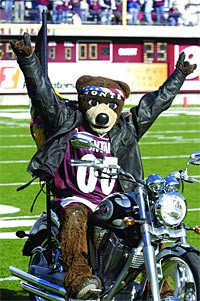 That
intrepid bear did it again. UM’s mascot, Monte, was
named the Capital One Mascot of the Year in January. Monte also
won the title in 2003.
That
intrepid bear did it again. UM’s mascot, Monte, was
named the Capital One Mascot of the Year in January. Monte also
won the title in 2003.
Last summer the bear was one of twelve critters from I-A and I-AA football programs around the country named to the Capital One All-American Team. Contestants submitted a video of their antics, and a panel of judges ranked the videos on fan interaction, sportsmanship, and community service. The judges’ vote counted for 50 percent in the final rankings and 50 percent came from online voting.
After a slow start, the UM bear surged in the polls, placing third in the online portion of the contest. “During the final weeks, Monte clawed ahead from eleventh to third place in the popular online voting,” says Pam Girardo at Capital One. “That, combined with the judges’ ranking, propelled Monte to the highest perch in the mascot world. Atta bear!”
Monte’s video highlights came from the 2003-04 athletic season. The man who wore the suit during that time was Barry Anderson, the UM graduate from Terry who has gone pro as Benny, the mascot for the Chicago Bulls.
Anderson reports that he watched all the Griz football games on the Internet last fall and that he’s pleased with what his successors have done with Monte.
“I wouldn’t want to follow those guys,” he says. “They’ve done some incredibly good work.”
Anderson says one of the best parts of winning the mascot championship this time around was beating James Madison University’s Duke Dog, who finished first in online voting. “It was nice to take down Duke Dog,” he says. “At least we beat them in something.” [In case you don’t live on this planet, JMU beat UM in the I-AA champion- ship game this year. See story on page 12.]
Stage Notes
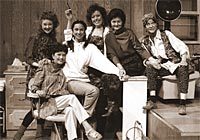 Mark
your calendar for UM drama/dance events, whether you live
in Missoula or not. The Montana Rep Theatre is currently touring
its 2005 production, Steel Magnolias, and may be coming to a
stage near you. Check out www.montanarep.org for the itinerary or
call (406) 243-6809 for information.
Mark
your calendar for UM drama/dance events, whether you live
in Missoula or not. The Montana Rep Theatre is currently touring
its 2005 production, Steel Magnolias, and may be coming to a
stage near you. Check out www.montanarep.org for the itinerary or
call (406) 243-6809 for information.
Evita, a production of the UM drama/dance department, opens April 5 in the Montana Theatre and runs through the 9th and again April 12-16. For tickets and information, go to www.umtheatredance.org or call (406) 243-4581.
Other productions this spring include: Hal Holbrook in Mark Twain Tonight, April 20; Trumpet Spectacular featuring Doc Severinsen and Allen Vizzutti with the Missoula Symphony Orchestra, April 24; the Buddy DeFranco Jazz Festival, April 29-30; Grease, May 1; and the Spring Dance Concert, May 4-7.
The box office number for the Masquer and Montana Theatres is (406) 243-4581.
Montana Teacher of 2004
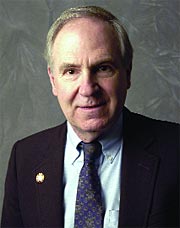 Many
people know him as Abraham Lincoln. Indeed, when he
dresses the part, he’s history come to life. But Harry
Fritz is much more than a symbol of the past. He’s the 2004
Montana Professor of the Year, named by two national
organizations that promote teaching excellence: The Carnegie
Foundation for the Advancement of Teaching and the Council for
Advancement and Support of Education.
Many
people know him as Abraham Lincoln. Indeed, when he
dresses the part, he’s history come to life. But Harry
Fritz is much more than a symbol of the past. He’s the 2004
Montana Professor of the Year, named by two national
organizations that promote teaching excellence: The Carnegie
Foundation for the Advancement of Teaching and the Council for
Advancement and Support of Education.
A sort of institution himself, Fritz has taught history at UM for nearly four decades and was nominated for the honor by UM President George Dennison. He is the fifth consecutive UM professor to win the award. Fritz has won every UM teaching excellence award given by administration and students—some of them twice.
Tall, lean, and Lincolnesque, the professor takes his impression of the U.S. president on the road each year, visiting schools, libraries, and historical societies across Montana.
An internationally recognized expert on the Corps of Discovery, Fritz’s book, The Lewis and Clark Expedition, was published earlier this year by Greenwood Press.
Sporting News
 Several
former Griz have distinguished themselves on the field
and court lately.
Several
former Griz have distinguished themselves on the field
and court lately.
Scott McGowan became the first Montanan to break the four-minute mile in January. A former All-American for the Griz track team, McGowan clocked in at 3 minutes, 58.91 seconds during the Reebok Indoor Games in Boston. The Poplar native finished seventh in a race loaded with elite runners.
Robin Selvig, UM’s Lady Griz basketball coach of twenty-seven years, continues to distinguish himself. Street & Smith’s magazine, the bible of college hoops, recently named UM seventh on its list of all-time best women’s basketball programs. UM and Selvig earned the ranking by winning twenty or more games in twenty-four of the last twenty-six seasons. Montana’s sixteen regular-season conference championships and fifteen conference tournament titles rank second in the nation, trailing only Old Dominion. In addition, Selvig’s 614-179 record ranks him sixth among active head coaches for winning percentage and tenth in victories.
Trey Young, a standout safety for the Griz football team from 1999 to 2002, has landed a two-year contract with the Calgary Stampeders of the Canadian Football League. He will report for training camp in May; the CFL season kicks off in June.
Young was MVP of the Big Sky Conference and Griz Defensive Player of the Year in 2002. He also was an essential component of the 2001 national championship team.
The President’s Corner
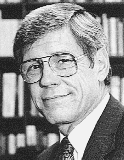 Several
recent studies conclude that intercollegiate athletics
detract from rather than add to the sponsoring
institutions’ efforts to fulfill their missions in
education. According to these studies, the athletics
programs—at all divisional levels—involve
relatively
small numbers of the enrolled students, focus more on
entertainment than education, impose great pressures on the
coaches and athletes to win rather than compete fairly, and drain
resources from other academic uses.
Several
recent studies conclude that intercollegiate athletics
detract from rather than add to the sponsoring
institutions’ efforts to fulfill their missions in
education. According to these studies, the athletics
programs—at all divisional levels—involve
relatively
small numbers of the enrolled students, focus more on
entertainment than education, impose great pressures on the
coaches and athletes to win rather than compete fairly, and drain
resources from other academic uses.
Moreover, the analytical studies find very little correlation between successful—meaning winning—athletics programs and private giving to the sponsoring colleges and universities. Among the so-called “elite” conferences, the “arms race” for enhanced facilities and amenities has resulted in escalating costs with no end in sight. In response, NCAA President Miles Brand has called for discussions to end the cost spiral and restore academic legitimacy and rationality to athletics.
One article in this issue of the Montanan focuses on the success of the Grizzly football team and the experience of one member of our alumni who traveled to Chattanooga to watch the championship game. Those who attended the playoff games in Missoula that led to the grand finale had the chance to observe the great outpouring of support for the Griz. During my years as President of the University, I have appreciated the strong and solid support provided by alumni and friends of the University for the Griz athletics programs. Moreover, I believe we can demonstrate that we have not succumbed to the “arms race” syndrome, but have maintained a reasonable institutional posture concerning athletics.
We seek to make certain that the support for the athletics programs remains consonant with support for all programs at the University. As one benchmark, we peg the athletics budget at roughly five percent of the total institutional budget, thereby allowing athletics to grow as the University grows. The second benchmark focuses on assuring that no more than five percent of the general funds in the education and general budget—the portion of the total University budget devoted to the instruction and student service programs—goes to athletics. These benchmarks have served us well, as demonstrated by the remarkable success of the programs. They also have enabled us to benefit from the willingness of Griz fans and supporters to contribute generously to the support of athletics and academics. I believe strongly that we have done well and will continue to benefit if we adhere to this principled approach.
George Dennison
’62, M.A. ’63
President
Dennison named to National board
UM President George Dennison received some exciting news in late December. He learned he’d been nominated by President George W. Bush for a four-year position on the National Security Education Board.
The board was established in 1991 by former President Bill Clinton to educate U.S. citizens about foreign cultures, strengthen U.S. economic competition, and enhance international security. Dennison is well qualified for the position. Aside from numerous years in higher education, he has maintained a strong interest in public diplomacy and international education and has spent a considerable amount of time in other countries forging student exchange opportunities.
The appointment must be confirmed by the U.S. Senate and Dennison says he believes its members will act soon on the matter.